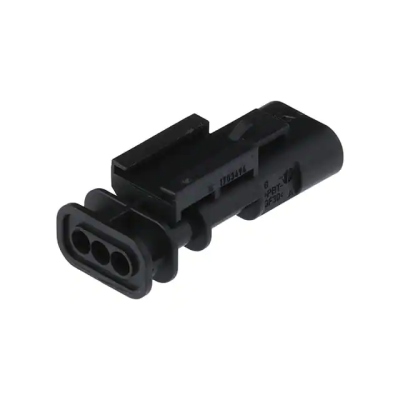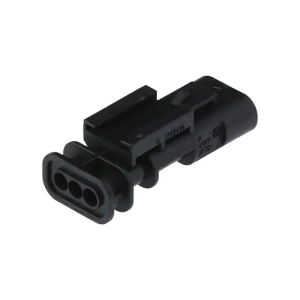1-1703494-1
Part Number: 1-1703494-1
Manufacturer: TE Connectivity
Description: Automotive Connectors 3P Tab Hsg Assy Coda
Shipped from: Shenzhen/HK Warehouse
Stock Available: Check with us
ICRFQ.com - Electronic Components Distributor in China Since 2003

Part Number: 1-1703494-1
Manufacturer: TE Connectivity
Description: Automotive Connectors 3P Tab Hsg Assy Coda
Shipped from: Shenzhen/HK Warehouse
Stock Available: Check with us
The 1-1703494-1 is a set of MCON 1.2mm sealed wire-to-wire tab housings for the automobile sector. These housings are a component of the MCON connector system. The MCON connector system was developed specifically for use in applications related to motor vehicles, characterized by high levels of vibration and exposure to mechanical stress.
The housings of these MCON connectors incorporate several features that make them ideal for use in these environments. Some of these features include Terminal Position Assurance (TPA), which locks the terminals inside the connector, and an external latch and keying to ensure accurate and secure mating. Other features include Terminal Position Assurance (TPA), which locks the terminals in place outside of the connector. The housings have a high temperature operating range of up to 125 degrees Celsius. These hermetically sealed MCON 1.2 Tab housings are designed to be used with 1.2mm wide locking lance tab contacts, which can be ordered separately.
| Cable Exit Angle | 180° |
| Color | Black |
| Body Material | PBT GF |
| Number of Positions | 3 |
| Number of Rows | 1 |
| Mating Tab Width | 1.2mm, .047in |
| Length | .74in, 18.8mm |
| Width | 44mm, 1.732in |
| Height | .589in, 14.95mm |
| Nominal Voltage Architecture | 12V |
| Operating Voltage | 14VDC |
| Centerline (Pitch) | 4mm, .157in |
| Polarized | No |
| Terminal Position Assurance | Yes |
| Mounting Feature | Without |
| Circuit Application | Signal |
| Connector Position Assurance Capable | No |
| Serviceable | Yes |
| Packaging Quantity | 1400 |
| Packaging Method | Box |
| Connector Style | Housing for male terminals |
| Strain Relief | No |
| Hybrid Connector | No |
| Primary Locking Feature | On the Terminal |
| Sealable | Yes |
| Connector System | Wire-to-Wire |
| Operating Temperature Range | -40 – 125°C, -40 – 257°F |

Electrical connectors of the sort known as “automotive connectors” are the kind that is required to link a piece of electrical equipment to a motor vehicle. Connectors of this type are sometimes referred to as automotive connections or vehicle connectors. A connection system is created by fusing two connections that are complementary to one another. On the male end, you will need male terminals or pins; on the female end, you will need female terminals or pins.
The most common sort of terminal that is manufactured is one that is constructed of stamped metal and can have a variety of platings and forms. Incorporating connected matched terminals (male and female) affords users the peace of mind that their electrical connections will continue to function reliably despite the time.
The major function of the car connector, which is a typical component of automobiles, is to establish connections between the numerous pieces of interior and exterior hardware found in the vehicle. Through the use of the proper automotive connection, it is possible to connect a wide variety of accessories found within the vehicle.
You also can enhance the safety and steadiness of the electronics utilized by the automotive connectors in the vehicle. During the procedure for automobile repair, you will need to connect the vehicle to extra equipment for the other detecting equipment to obtain up-to-date information on the vehicle’s state. The automotive connection has a significant amount of importance because it can link a variety of automobile manufacturers to the essential apparatus.
Connecting two wire-terminated connectors requires the utilization of wire-to-wire connectors. Electrical connectors, electronic connectors, and computer connectors are all applications for these components. The mating combination of a wire-to-wire connector, the gender, the number of circuits or locations, and the wire size is all general requirements. Connectors for wires to wires that are male are intended to be inserted into connectors for wires to female wires.
Connectors from one wire to another must adhere to electrical and mechanical standards. Electrical parameters include the maximum current that can flow, the maximum voltage that can be applied, the maximum voltage that can be sustained, the contact resistance, the insulation resistance, and the number of rows or contact points. Maximum current, or the capacity to carry a current, is measured in amps (A). The range for this measurement is from 1.0 A to 50 A. 25 volts, 30 volts, 100 volts, 125 volts, 250 volts, 300 volts, 500 volts, 600 volts, and 1000 volts are some of the options for maximum voltage and voltage resistance, respectively.
Electrical measurements can be made across or between contact surfaces to determine the contact resistance. The ratio of the applied voltage to the total current is the definition of insulation resistance. It describes the relationship between two electrodes in contact with a certain insulator. In most cases, the number of rows will be anywhere from one to four. The wire pull-out force, minimum un-mating force, minimum normal force, maximum mating force, maximum contact insertion force, and minimum contact retention force are some of the mechanical criteria for wire-to-wire connectors.
When choosing wire-to-wire connectors, the termination method is a crucial feature to consider. The following options are available: crimp to crimp, IDC to IDC, crimp to IDC, screw, FFC/FPC to crimp, quick disconnect to quick disconnect, FFC/FPC to FC/FPC, and IDC to FC/FPC. Crimp termination is a connection method for a wire-to-wire connector in which a metal sleeve is fastened to a conductor using mechanical crimping. This method is also known as a crimp-on termination. The insulation displacement connection method, also known as IDC, involves inserting an insulated wire into a slot whose width is narrower than the diameter of the conductor. Flat flex cables, also known as FFCs, can have a smooth or corrugated outside but always have two flat surfaces. It is also common practice to use flat printed circuits, abbreviated FPC, for wire-to-wire connectors.
If you have any concerns regarding the information presented in this article, please do not hesitate to leave them in the comment box below, and we will try our best to respond to them. Contact ICRFQ if you require information or want to place an order for 1-1703494-1. Because we are the most reputable electronic components distributor in China, you may feel at ease knowing that we will take care of you.
WhatsApp us